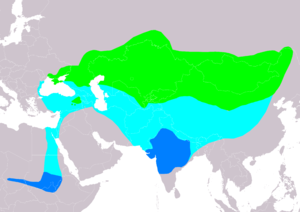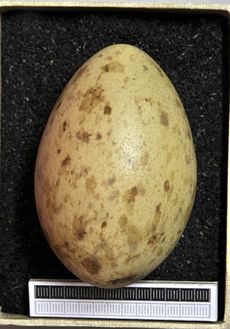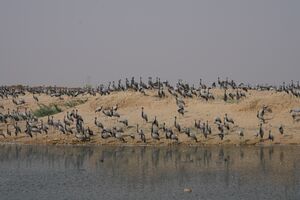رهو
| رهو | |
|---|---|

| |
| Flock at Tal Chhapar Sanctuary, Churu, Rajasthan | |
| التصنيف العلمي | |
| أصنوفة غير معروفة (أصلحها): | Grus |
| Species: | Template:Taxonomy/GrusG. virgo
|
| Binomial name | |
| Template:Taxonomy/GrusGrus virgo | |

| |
| Range of G. virgo Breeding Passage Non-breeding | |
| Synonyms | |
| |
رهو (الاسم العلمي: Anthropoides virgo) إنگليزية: Demoiselle Crane هو طائر ينتمي إلى كركي (فصيلة: Gruidae).
السلوك والبيئة

في الثقافة
The demoiselle crane is known as the Koonj /Kurjan(कूंज,कुरजां کونج, ਕੂੰਜ) in the languages of North India, and figure prominently in the literature, poetry and idiom of the region. Beautiful women are often compared to the koonj because its long and thin shape is considered graceful. Metaphorical references are also often made to the koonj for people who have ventured far from home or undertaken hazardous journeys.[2]
The name koonj is derived from the Sanskrit word kraunch, which is a cognate Indo-European term for crane itself.[3] In the mythology of Valmiki, the composer of the Hindu epic Ramayana, it is claimed that his first verse was inspired by the sight of a hunter kill the male of a pair of demoiselle[بحاجة لمصدر] cranes that were courting. Observing the lovelorn female circling and crying in grief, he cursed the hunter in verse. Since tradition held that all poetry prior to this moment had been revealed rather than created by man, this verse concerning the demoiselle cranes is regarded as the first human-composed meter.[4][محل شك]
The flying formation of the koonj during migrations also inspired infantry formations in ancient India. The Mahabharata epic describes both warring sides adopting the koonj formation on the second day of the Kurukshetra War.[5]
انظر أيضا
مراجع
- ^ BirdLife International (2012). "Anthropoides virgo". IUCN Red List of Threatened Species. 2012. Retrieved 26 November 2013.
{{cite journal}}: Invalid|ref=harv(help) - ^ Department of English, University of Delhi. The Individual and Society. Pearson Education India, 2005. ISBN 978-81-317-0417-2.
... kunj: more properly koonj is a demoiselle crane. The word is used metaphorically for a young bride far from her home ...
- ^ خطأ استشهاد: وسم
<ref>غير صحيح؛ لا نص تم توفيره للمراجع المسماةref67xemux - ^ Dinkar Joshi; Yogesh Patel. Glimpses of Indian Culture. Star Publications, 2005. ISBN 978-81-7650-190-3.
... Valmiki saw a pair of kraunch (cranes) birds making love. Suddenly, a hunter killed the male kraunch with an arrow. Valmiki was moved by the cries of the female ... Valmiki's pain was expressed through a shloka ... The first man-composed meter ...
- ^ Ramesh Menon. The Mahabharata: A Modern Rendering. iUniverse, 2006. ISBN 978-0-595-40188-8.
... The second day: Two kraunchas ... Yudhishtira decides to form his legions in the vyuha called the krauncha, after the crane ...
- Cite iucn maint
- Short description with empty Wikidata description
- أنواع القائمة الحمراء غير المهددة
- Automatic taxobox cleanup
- Articles containing إنگليزية-language text
- Pages using Lang-xx templates
- Articles with unsourced statements from February 2013
- مقالات ذات عبارات محل شك
- حيوانات وصفت في 1758
- طيور پاكستان
- Birds of Central Asia
- Birds of Mongolia
- Birds of Central Africa
- Birds of East Africa


